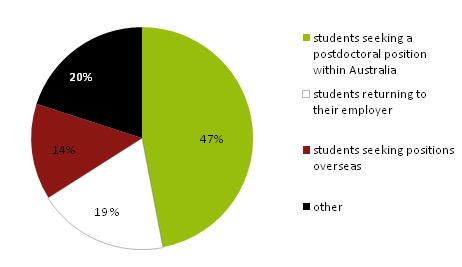You are here: Home > Education and Training: An update
Education and Training: An update
It is with much pleasure that we congratulate Mr Mark Stanaway on the submission of his PhD thesis Hierarchical Bayesian Models for Estimating the Extent of Plant Pest Invasions for examination. Mark was granted leave from his employer, Department of Employment, Economic Development and Innovation, to undertake his PhD with the CRC, commencing in late 2006. All four of his supervisors, Professor Kerrie Mengersen, and Drs Rob Reeves, Grant Hamilton and Peter Whittle were based at Queensland University of Technology (QUT). Mark’s thesis investigated the use of hierarchical Bayesian models as decision-making tools for plant biosecurity surveillance activities. He used case studies of the spiralling whitefly (Aleurodicus disperses) and the red-banded mango caterpillar (Deanolis sublimbalis) to examine how pests can spread, incorporating human-assisted movement, ecological factors, and uncertainty. The tools developed in his study may assist future assessment of area freedom and effective management of incursion response programs. Mark has published one paper from his PhD and is currently preparing two further papers. We congratulate Mark on his submission and eagerly await the outcome of the examination period.
Close on the heels of Mark was Nichole Hammond who submitted her thesis on October 27. Nichole was also granted leave from her employer, the Department of Agriculture and Food, Western Australia (DAFWA) commencing her PhD in early 2007. Nichole enrolled at Murdoch University and was supervised by Dr Simon Reid, with input from Dr Darryl Hardie and Dr Tony Martin (DAFWA), Dr Grant Hamilton (QUT) and Dr Cindy Hauser (Australian Centre of Excellence for Risk Analysis). In a similar vein to Mark, Nichole examined decision-making tools for surveillance, using Karnal bunt (Tilletia indica) as her case study. Nichole also conducted a survey of growers to examine the level of detecting and reporting of high priority pests in the grains industry. We wish Nichole the best of luck during the examination process.
With a number of students nearing the end of their PhD studies it was considered timely to conduct a survey of their post-PhD plans.

A total of 32 of our students responded with the results indicating that following submission, 47% of students will be seeking a postdoctoral position within Australia, 19% will be returning to their employer (as they were granted study leave to complete their PhD), 14% will be seeking positions overseas, and the remainder are happy to work anywhere. Of the respondents, 60% indicated they would prefer a career in plant biosecurity, with 40% happy to work in the broader biosecurity arena. Thankfully none of the students said they were not interested in a career in biosecurity of any sort! This bodes well for the CRC’s goal to increase Australia’s capacity in plant biosecurity.
Enrolments in the 2011 enrolments for a postgraduate Certificate, Diploma or Masters in Plant Biosecurity are now open. This postgraduate study in plant biosecurity has been developed specifically for those working in the plant biosecurity sector or for people who wish to pursue a career in plant biosecurity. The courses are delivered entirely online so students are able to fit study around their busy lifestyles at a time and place that is convenient for them.The courses are also offered asindividual units which means they can be studied by people with an interest in a specific topic or those who are not sure they want to commit to a full certificate, diploma or masters. If you are currently enrolled in another postgraduate course you may be able to complete units from the plant biosecurity program and have them count towards your qualification. The cost of each unit, with the exception of the Masters Dissertation, is from AUD$2,500 for 2011 (depending on where you enrol). If you require any further information please refer to the Plant Biosecurity Program website or contact Dr Kirsty Bayliss.
Article written by: Dr Kirsty Bayliss

